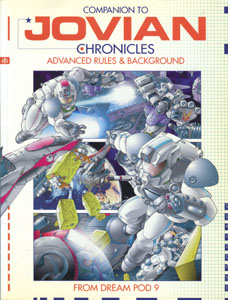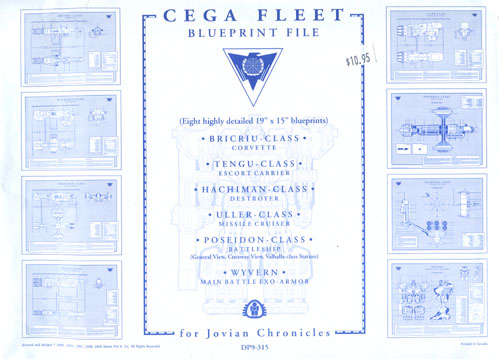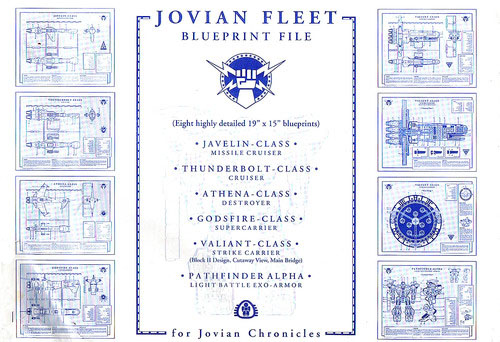Tagline: A book which doesn’t quite seem to know what it’s trying to accomplish, but succeeds through a sheer mass where it may fail in style. Recommended.
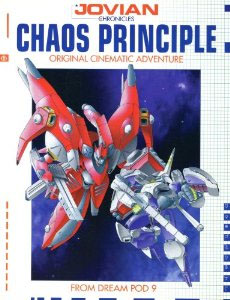 This is the worst Dream Pod 9 product I own, with the exception of Video Fighter (see my review). It’s still better than the vast majority of the products on the market (a testament to Dream Pod 9’s outstanding strengths), but is critically flawed in several areas.
This is the worst Dream Pod 9 product I own, with the exception of Video Fighter (see my review). It’s still better than the vast majority of the products on the market (a testament to Dream Pod 9’s outstanding strengths), but is critically flawed in several areas.
First off, the book is slightly schizophrenic. About fifteen minutes into reading it I suddenly realized I had no idea what the product methodology was supposed to be. What I mean is that, when you buy a roleplaying supplement, the supplement is supposed to do something – and that something should be very specific. Deities and Demi-Gods describes deities and demi-gods for AD&D. Berlin by Night describes the city of Berlin in the World of Darkness. And so forth.
But who sat down at Dream Pod 9 one day and said to themselves: “Let’s make a book with a bunch of information on the Jovian Confederation; some tidbits regarding the Martian War; an adventure/campaign set in and around the Jovian Centennial; a tactical campaign set around/on Mars; a bunch of vehicles designs for Mars, Jupiter, and CEGA; a mis-named “JPDS Campaign”; and a semi-update to the year 2213.”
I began to think, in short, that the word “chaos” had been well chosen.
The second major problem is that this is a book ahead of its time. Rule number one of the design of an effective roleplaying line is that, before you can take the line anywhere, you must first establish a baseline. Rule number two would be that, when you take the game line somewhere, make sure the GMs and players have all the info they need to go there with you. Chaos Principle provides a partial update to the year 2213 (from the year 2210, which is the baseline of the setting) – and therein lies the problem: A partial update. There are too many unanswered questions about what happened in the interim for me to successfully run a campaign here.
Finally, the book is the poster child for the serious editorial problems which plagued Dream Pod 9 during 1998 and early-1999. During this time frame the Pod was suffering from a combination of personnel changeover and rushed production schedules, resulting in poorly copyedited texts – typos and editorial marks, for example, were routinely left in the text. This book takes the award for the worst of the batch, however, with all the problems of other books, plus a page where the text which is supposed to be there has been wiped out by a mistaken cut-and-paste from another section of the book (the correct text for page 11 can be found on the Pod’s website and will be corrected in future printings). (It should be noted, also, that the Pod is now over these difficulties. Their last handful of products have been spotless in my experience.)
The upside is that this 128 page book is chock full of all sorts of different stuff. Perhaps the best analogy would be a grab bag. With a grab bag you have the disadvantage that there is no coherency to what you’ve purchased, but you have two advantages as well: First, that you get a wide variety of stuff. Second, that you might just find a gem or two inside.
UPDATE TO 2213
Chaos Principle is primarily described as an “Original Cinematic Adventure” (or OCA). This is a wordplay on “Original Video Animation” (or OVA), a term for anime which was designed to be sold direct-to-video. Typically an OVA is a stand-alone story, even if it uses characters from a series with a story arc (which, while being limited to Babylon 5 in this country, is fairly typical with Japanese anime).
So, as an OCA, Chaos Principle is designed to be an adventure book – describing a short campaign centered around the events of the Jovian Centennial celebration. I’ll be discussing that component of the book a little later on.
At a more basic level, however, the book is serving as a semi-update to 2213. An update because it provides details of events which happen between 2210 (when the core rulebook is set) and 2213, “semi” because it doesn’t do a very thorough job of it. Specifically: Information relating to the Jovian Confederation is given in great detail, while events elsewhere in the solar system are covered briefly if at all.
What you end up with is almost unusable except in the context of this single product. You know, for example, that General Thorsen (the Jovian commander responsible for the Odyssey) has escaped and then went to Venus to engage in some guerilla combat… but once Thorsen is outside the Confederation’s dominion suddenly you don’t know what happened next (specifically, what happened on Venus).
I understand the methodology behind this (this campaign is set in the Confederation, so you provide Confederation-related information), but it’s bad methodology. As I mentioned before, this book would have been much better off if it had been released two or three years from now – once we knew the Jovian Chronicles setting better and more support product had been provided. As it is, we’ve got this campaign out in 2213 (which you can run fairly effectively), but that’s all you have. I don’t know enough about the solar system of 2213 from this product in order to run a campaign there and, quite frankly, that time period is not going to be supported for some time to come yet (since now they need to backtrack and fill in all the holes in 2210).
JOVIAN CONFEDERATION SOURCEBOOK
Because there hasn’t been a Jovian Confederation sourcebook published yet, it’s not sufficient for Chaos Principle to simply provide an update – it’s going to have to provide you with some additional setting information in order to make the campaign playable.
My problem with this section is not its competency or its completeness. Wunji Lau does an excellent job of expanding our knowledge of the Confederation from the information found in the core rulebook. You get a societal overview, a look at some of the major colony cylinders, a little historical information, a look at some major organization, and an analysis of some major characters in the setting. All-in-all, an excellent resource – and anybody wanting to set a campaign in, around, or involving the Jovian Confederation should definitely pick up this book.
No, my problem is not competency. My problem is that someday the Pod is going to have to release a full-scale Jovian sourcebook. And when that happens it’s going to be exceptionally difficult to pull it off successfully. Why? Because you’re going to be in the unsavory position of making a tough choice: Do you duplicate the information found in Chaos Principle? Or do you attempt to present all-new information?
If you choose the former path, then you’ll have successfully produce a Jovian Confederation sourcebook which can stand on it’s own. You’ll be able to pick up that book, just as you should, and have the rock-solid foundation you need to run a Confederation campaign. But there are two problems. First, those of us who already own Chaos Principle will be buying repetitious material. Second, those who don’t already own Chaos Principle (they’re new to the line, for example), will end up with repetitious material when/if they do buy it. Either way, you’re lowering the overall informational value of the two products.
On the other hand, if you present all-new information in this hypothetical Jovian Confederation sourcebook, you have now created a dependency relationship between the two products. Now, in order to have a complete foundation for a Confederation campaign, you’re going to have to own both this sourcebook and Chaos Principle. You’d end up hurting the primary sourcebook by making it rely upon a secondary supplement.
Once again, these problems are created by the fact that the book is two or three years too early. If the book had been produced at some point after the release of a Confederation sourcebook than the writer could have simply assumed it as a prerequisite (and, therefore, sufficed himself with a simple update to the material found in it). Heck, with the extra space he could have then gone on to provide the additional update material in order to make any 2213 campaign feasible with the purchase of this book (see how it all hooks together?).
THE MARTIAN WAR
One of the things we learn from the update is that the cold war has suddenly decided to heat up. The Martian Free Republic (allies of the Jovian Confederation) have been implicated in the destruction of the orbital elevator during the events of the Odyssey. The Martian Federation (allies of CEGA), who controlled the elevator, are enraged by this knowledge. Tensions rise and finally break as the Federation declares war on the Free Republic. As things begin to spiral into chaos, both the Jovian Confederation and CEGA dispatch fleets to Mars.
Can you hear the ominous music playing in the background?
This is cool stuff. Things get weird, however, when the book presents a mini-tactical campaign focusing on three major battles (two on the surface, one in space). There’s nothing wrong with these scenarios, but why are they here?
Before reading the book I assumed that the tactical scenarios were somehow related to the roleplaying campaign (as was done with The New Breed campaign book for Heavy Gear). Such is not the case. The roleplaying campaign has absolutely no connection to the tactical campaign (indeed, the roleplaying campaign gets nowhere near Mars).
Obviously the book is trying to make it worthwhile for a tactical player to pick it up (since they would benefit from the update material). In the long run, however, it sticks out like a sore thumb – symptomatic of the misguided grab bag nature of the book.
(On a side note: I’m not too sure how I feel about the Battle of Kurtzenheim and the events which follow it. I won’t spoil it for you here, but there is a certain degree of anti-climax to it.)
THE JOVIAN CENTENNIAL
This is the core of the book – the Original Cinematic Adventure which is focused on the events taking place around the Jovian Centennial celebrations.
Dream Pod 9 does some fascinating things as designers – they always have a firm understanding of not only what methodology they’re using to design a product, but the impact that methodology has (which is why the failure for a clear methodology to present itself in this product is so odd). One of the ways in which this manifests itself is in the innovative manners in which they present campaign and adventure material (reference my reviews of The Paxton Gambit and The New Breed for more details).
Here they’re trying something a little different, but once again they seem to have a fairly good grasp of what the essential elements are – which allows them to play around with the other ones to their heart’s content.
First, you are given a variety of tools which let you get your players involved. Primarily, the book gives you four default characters (Ariana, Jared, Khoi, and Joseph). Think of these guys as the cast of your favorite television shows – they have vivid personalities, interrelationships, etc. The easiest thing to do is to have the players step into these character’s shoes and proceed.
They’re not content to simply let that be the only way, though. The book also provides three different sets of “hooks” to get you involved. The first set, the “Campaign Hooks”, are ways of pulling in non-standard PCs to the general campaign. The second set, “In Media Res”, assume that Ariana, Jared, Khoi, and Joseph are still present and carrying out their “default actions” (more on that in a moment) – the PCs get involved in the evolving campaign at different points in the middle of the action (which is what “in media res” means).
But it is with the third set of hooks – the “Adventure Hooks” that you begin to feel that things aren’t coming together quite right. These hooks suggest “alternate” campaigns which would only use the presented campaign material as a “backdrop” for the actions which the PCs are taking.
Which is a neat idea, in and of itself. It only falls apart later on, when you read past the campaign material, and hit some other stuff: Like “Secondary Effects” and “Adventure Seeds” – both of which have very similar goals. The way this should have been done would be to isolate all of this material together (preferably after the campaign material, because trying to discuss alternatives to material the GM hasn’t even read yet is pretty ineffective). This would provide a sort “united front” and make it easier for the GM to access the toolbox, so to speak.
Now, for the campaign itself. It is broken into four phases (“Introduction”, “Emergence”, “Action”, and “Climax”), each composed of various scenes. The cool part is that each scene is dynamic – with multiple entry and exit points. At this most basic organizational level, this format has a tremendous amount of potential. In the actual execution, however, things go a bit askew.
Each scene description is broken into two parts: A semi-narrative description of what happens and a set of “Adventure Suggestions”. Essentially, the semi-narrative (which reads like a scene outline) describes the default actions of the pre-established cast. In other words, if you just read through these you’d have an idea of what would happen if the PCs weren’t involved at all (or if the players weren’t controlling the actions of the primary cast members). The “Adventure Suggestions” section then outlines exactly how the situation should be handled in game terms.
If done properly, the dual nature of the scene descriptions (coupled with the dynamic scene connections) would end up providing the best of both worlds: An active, established storyline – from which the PCs can easily deviate. In the actual practice of the Chaos Principle, however, this doesn’t happen – to the point where, if you don’t generate completely original material, the PCs are going to be extremely railroaded at certain junctions.
Beyond this, there are several structurally questionable narrative choices: Such as having the default cast of four start out as two separated teams of two who have no knowledge of or connection to each other.
All that being said, the story itself is extremely engaging: A neo-nationalist group known as the Principii believe that they, and only they, can save the Jovian Confederation from its worst enemies. To do this they want to start a war with CEGA (a war which, obviously, the superior Confederation will easily win). With a senior CEGA official (Ignatius Chang) in the Confederation for the Centennial celebrations and warships on their way to Mars, the Principii see a rare opportunity: Assassinate Chang and you start a war. The PCs stumble onto the plot from different ends, meet up in the middle, and have everything come down to a climactic battle between experimental exo prototypes.
Once again, rock solid material. But the pieces just don’t fit quite the way they should.
ODDS AND ENDS
Let’s see… We’ve got an update, a sourcebook, a tactical campaign, and a roleplaying campaign. Isn’t that enough for one book?
Apparently not.
There is, for example, an extensive (30 page) technical supplement – detailing equipment, technical updates, new vehicles, etc. Also, there is a completely bizarre, three page, “sample campaign”. It is titled “JSPD Blue” (for Joshua’s Station Police Department) and deals with the ESWAT (Enhanced Special Weapons and Tactics – i.e., they use combat exo-suits and deal with extreme situations) team on Joshua’s Station. And there’s some other stuff spread throughout the book in a faintly haphazard manner.
CONCLUSION
Chaos Principle could be a truly excellent book, but somewhere along the line things just didn’t gel right. That being so, let me explain why I give the book the relatively high marks (double fours) that I do:
Style. Well, the book takes a hit for the handful of instances where material is unnecessarily spread out or laid out in an unintuitive fashion (for the most part, this isn’t true, though). It takes another hit for the typos and the misplaced text. But it gets a boost from the fact that, where the text isn’t compromised by poor editorial control, it is clear, concise, and informative. It gets another boost due to the (typically) outstanding artwork of Mr. Ghislain Barbe. It’s too strong to be below average (1 or 2), and too weak to be truly outstanding (5). So this leaves me with “average” (3) and “better than average” (4). For me the strengths outweigh the flaws, so it gets a four.
Substance. It takes a hit because of the scatter-shot approach of the material. It takes another hit because of the insufficient update material. It then takes a third hit from the flaws in the campaign material. With most companies, this trio of flaws would be enough to send the book spiraling to at least an average rating, if not worst. But the Pod succeeds at packing so much material in here that it nicely counteracts these negative aspects. In other words, it may be a grab bag – but it’s a really big grab bag. And the stuff in it is of above-average quality for the most part. So it slides by with a four.
Nonetheless: Probably the worst Pod product I’ve read. The fact that it still scores as highly as it does with me is an indication of the quality which the Pod normally produces.
And, at the end of the day, I have to strongly suggest that any fan of Jovian Chronicles pick this book up. There’s just too much territory covered in it, in various forms, for it to be lacking from your game shelf.
Style: 4
Substance: 4
Author: Wunji Lau
Company/Publisher: Dream Pod 9
Cost: $20.95
Page Count: 128
ISBN: 1-896776-24-8
Originally Posted: 1999/10/23
Hopefully the real conflict I was feeling in trying to rate this mish-mash of a product was clearly communicated in my conclusion. In retrospect, however, I feel that I was much too kind to it: The campaign material is a mangled mess that would require far too much work to actually bring to a gaming table; the rest of the material is a grab-bag of irrelevancy for anyone using the core 2210 time period for their campaign; and, with the benefit of hindsight, it’s really clear that this was the first warning sign that the Jovian Chronicles product line was about to implode into mediocrity and nonsense (something which I describe in more detail in the postscript to this review). I suspect that a more accurate rating of Substance would have been 3 (or possibly even a 2).
For an explanation of where these reviews came from and why you can no longer find them at RPGNet, click here.
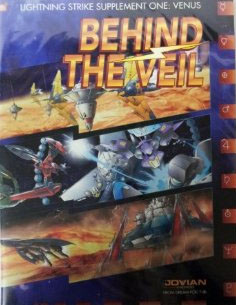 Let’s cut to the chase on this one.
Let’s cut to the chase on this one.

